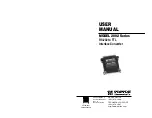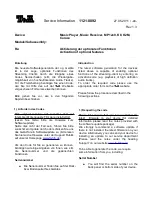10
1.3.1
HD Format Notation
HDTV formats are referred to using a notation describing:
There are 2 main HD resolutions 720 and 1080. Usually (but not always) HD pixels are square, meaning that if the
vertical resolution is 720, to achieve a 16:9 aspect ratio, the horizontal resolution must be 1280. For 1080 the
horizontal resolution is usually 1920. Sometimes, for clarity, the full resolutions are written e.g. 1280x720p60.
Most HDTV systems support some standard resolutions and frame or field rates. The most common are:
480p60, 576p50, 720p50, 720p60, 1080i50, 1080i60
p = Progressive, i = Interlaced
HD MediaBox will initially display in 480p60 as this is THE most commonly supported resolution.
A frame or field rate can also be specified without a resolution. For example 60p means 60 progressive frames per
second and 50i means 50 fields per second.
1.3.2
Interlaced and Progressive
HD formats can be either progressive (p) or interlaced (i). Progressive means each time the image refreshes (60
times a second for NTSC, 50 times a second for PAL) the video signal contains the full resolution. However, with
interlacing, each time it refreshes you only get half the resolution (known as a field) - every odd line one field and
every even line the next. All SD video formats are interlaced, as is DVD.
Obviously progressive scan is the higher quality of the 2 systems, but also has larger file sizes.
However, many modern digital display technologies such as Plasma, LCD and DLP inherently progressive scan i.e.
they have to show all the lines of resolution at the same time. Somewhere in the video chain, some device has to
convert interlaced signals into progressive signals for these displays. This task is called Deinterlacing. Most of these
displays will include the technology to do this, however this is a very complex process and HD MediaBox may do a
better job.
Arguments are common about which looks better - 720p or 1080i? It is common for people to prefer the stability
of 720p for subject matter containing a lot of rapid motion (soccer, basketball or hockey games, for example).
You may want to experiment in your own setup to see which you prefer.
1.4
Supported Formats
1.4.1
A Brief Overview of Video Formats
All standard video formats are compressed. The amount of compression and the data rates of these standards vary
enormously. Often files made available for download, will be highly compressed (in order to save bandwidth),
resulting in a lower image quality.
MPEG-1
MPEG-1 is the designation for a group of audio and video coding standards agreed upon by MPEG (Moving
Picture Experts Group). 1.5Mbit/second data rates and 352x240 resolution are common with later improvements
allowing for up to 4Mbit/second for better quality.


















